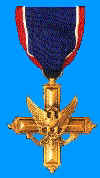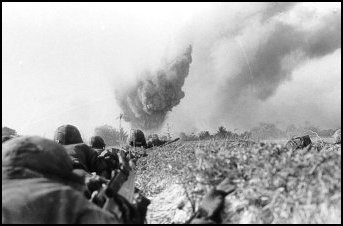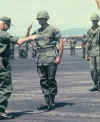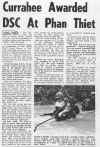|
Lt.
James R. Magouyrk Awarded DSC At Phan Thiet
 We salute Lieutenant
James “Jim” Magouyrk, 22-year-old platoon leader and native of
Los Angeles, California.
Jim enlisted in the military service on June 19,1964 and took
Basic Training at Fort Ord, California in June-August 1964.
He attended AIT at Fort Knox, Kentucky.
In August 1967, he attended Officer Candidate School (OCS) at
Fort Benning, Georgia and was commissioned an Infantry Lieutenant
upon completion of OCS in February 1968.
In October of that same year, Jim attended Jump School at
Fort Benning, Georgia.
Shortly after completing his airborne training, 2Lt. Magouyrk
received orders for Vietnam and arrived in country in December 1968.
He was eventually assigned to the 3-506 at Phan Thiet, where
he assumed command of 2nd Platoon, Company C, commanded
by Captain Joseph B. Jones III.
We salute Lieutenant
James “Jim” Magouyrk, 22-year-old platoon leader and native of
Los Angeles, California.
Jim enlisted in the military service on June 19,1964 and took
Basic Training at Fort Ord, California in June-August 1964.
He attended AIT at Fort Knox, Kentucky.
In August 1967, he attended Officer Candidate School (OCS) at
Fort Benning, Georgia and was commissioned an Infantry Lieutenant
upon completion of OCS in February 1968.
In October of that same year, Jim attended Jump School at
Fort Benning, Georgia.
Shortly after completing his airborne training, 2Lt. Magouyrk
received orders for Vietnam and arrived in country in December 1968.
He was eventually assigned to the 3-506 at Phan Thiet, where
he assumed command of 2nd Platoon, Company C, commanded
by Captain Joseph B. Jones III.

Two months and
two days after assuming command of his platoon, young Lt. Jim
Magouyrk would earn our Nation’s second highest award for valor
second only to the Medal of Honor in the “Battle at Outpost
SARA” on February 12, 1969.
The following is a factual account of the events concerning
2nd Platoon, Charlie Co. in the battle, including Lt.
Magouyrk’s personal recollections of a day in his life
that he will never forget.
The
“Battle at Outpost SARA"
(February
12, 1969)
On February 4, 1969 Task Force 3-506 commenced the first of
three phases for Operation HANCOCK EAGLE and would encounter some of
the Currahees fiercest fighting for the year.
The first significant enemy contact during Phase I of
Operation HANCOCK EAGLE occurred on February 5, when 1st
Platoon, Company C killed a lone Viet Cong and captured some
documents. Later that
same day, another lone Viet Cong carrying documents was killed.
Information from the captured documents led the Currahees to
a large Viet Cong supply point along Highway 8B.
A subsequent night ambush along the enemy supply route caught
an NVA caravan in the early morning hours.
These incidents, together with other information gathered
from captured documents, revealed a large enemy guild-up in the
area.
In the early morning hours of February 12, elements of the
Viet Cong 450th Local Force Company guided the Sapper
Companies of the Viet Cong 186th Main Force Battalion,
the 240th NVA Battalion, and the 840th Main Force
Battalion in an attack on Outpost SARA, located on Highway QL-1
northeast of Phan Thiet. Lt.
Magouyrk, platoon leader of 2nd Platoon, Charlie Co. was the
Battalion duty officer on the night of February 11 and was
monitoring the radios when the outpost was attacked.
His platoon was the scheduled reaction platoon for February
12, and Lt. Magouyrk knew that this meant an eventual
call for movement to assist at the contact area.
An hour later, Lt. Magouyrk and his
twenty-one-man platoon were on the chopper pad and ready to be
airlifted to the vicinity of Outpost SARA.
There would be three lifts of seven men each for the short
trip north of Phan Thiet. Lt.
Magouyrk recalls, “About a minute out, Blackhawk (Bn.
Cmdr. LTC Manuel A. Alves) came up on the radio and told me that we
were facing about a battalion of VC/NVA and that we were going to be
put down on a hot LZ right in the middle of the enemy, with a
promise of immediate backup. The
tactic we were employing was a classic technique for fixing the
enemy in one position while reinforcements are brought up to
eliminate them—we called it ‘dog pile on the rabbit’.
The tactic itself didn’t bother me near as much as the fact
that we would be practically surrounded by a whole battalion of
enemy.”
The "Polecat" slicks from the 192nd AHC carrying
the Currahees of 2nd Platoon touched down on the
designated LZ and were greeted by stiff resistance from the
well-entrenched enemy as they off loaded onto an open rice paddy.
Corporal Billy Frank Harper, 19, from
Cleveland, Mississippi was immediately hit in the leg; and Lt.
Magouyrk knew that they had to get to adequate cover and
away from the open LZ. The
heavy enemy fire seemed to come from all directions, and the only
visible cover was a ditch along the edge of the rice paddy to the
north. As the platoon
scrambled to cover, Lt. Magouyrk was wounded by
shrapnel from an exploding B40 rocket.
Second Platoon had combat assaulted right into the teeth of
an enemy ambush, not more than ten meters from a banana grove where
most of the enemy were entrenched.
The ditch offered the Currahees adequate cover; and
fortunately for them, the enemy had not covered it by fire.
It was still quite a heated exchange of fire, with hand
grenades and rifle fire being volleyed back and forth amid the
constant mortar and rocket explosions.
The Currahees of 2nd Platoon suffered more
casualties, as they continued to be helplessly pinned down in the
ditch at the edge of the rice paddy.
 Attempts
to bring in the next series of lifts carrying 1Lt. Larry
Terbush’s 1st Platoon were futile; the lead
"Polecat" slick (aircraft) received a hit as it approached
the LZ, and the entire lift of four choppers passed over the LZ to
the northwest. The lead
chopper eventually went down, but the remaining three choppers made
a second pass at the LZ and quickly off loaded the men of 1st
Platoon. 1Lt.
Wayne Thompson’s 3rd Platoon were inserted some
two hundred meters away from the original LZ where 1st
and 2nd Platoons continued to be mercilessly pinned down
by mortars, B-40 rocket fire, and machinegun fire. Attempts
to bring in the next series of lifts carrying 1Lt. Larry
Terbush’s 1st Platoon were futile; the lead
"Polecat" slick (aircraft) received a hit as it approached
the LZ, and the entire lift of four choppers passed over the LZ to
the northwest. The lead
chopper eventually went down, but the remaining three choppers made
a second pass at the LZ and quickly off loaded the men of 1st
Platoon. 1Lt.
Wayne Thompson’s 3rd Platoon were inserted some
two hundred meters away from the original LZ where 1st
and 2nd Platoons continued to be mercilessly pinned down
by mortars, B-40 rocket fire, and machinegun fire.
 By noon, the Currahees were still fighting a fierce battle with the
well-entrenched enemy for control of the LZ.
Running low on ammunition and in desperate need of medevac
choppers for the wounded in his platoon, Lt. Magouyrk
decided to call in airstrikes. The lieutenant knew well that even a
small error in distance could be disastrous for he and his men, but
still he gave an azimuth for the jets to fly that was quite close
and parallel to the ditch so that his men would not be on the
gun-target line. Lt
Magouyrk recalls, “I threw a smoke grenade as far as I
could and told the FAC (Forward Air Controller) to instruct the jets
to hit the smoke and prayed that they would not miss.
As the pair of F-4 Phantoms came screaming in, some of the
expended brass from their mini-guns was bouncing off our helmets.
Man those guys were good—they put those rounds exactly
where we needed it!”
By noon, the Currahees were still fighting a fierce battle with the
well-entrenched enemy for control of the LZ.
Running low on ammunition and in desperate need of medevac
choppers for the wounded in his platoon, Lt. Magouyrk
decided to call in airstrikes. The lieutenant knew well that even a
small error in distance could be disastrous for he and his men, but
still he gave an azimuth for the jets to fly that was quite close
and parallel to the ditch so that his men would not be on the
gun-target line. Lt
Magouyrk recalls, “I threw a smoke grenade as far as I
could and told the FAC (Forward Air Controller) to instruct the jets
to hit the smoke and prayed that they would not miss.
As the pair of F-4 Phantoms came screaming in, some of the
expended brass from their mini-guns was bouncing off our helmets.
Man those guys were good—they put those rounds exactly
where we needed it!”
Lt. Magouyrk informed Cpt. Jones
that he did not think he had enough men to take the banana
grove considering the number of weapons firing at his platoon, and
asked his commander for more fire support to soften it up more , and
tried to get the tank platoon that was in the area over to help them
out. "We took a couple of more casualties," says
Lt. Magouyrk. "The field first, SFC Jones and
my own RTO, SP4 Alexander. SP4 Vestal Alexander looked bad,
he had two holes in his neck, one on each side and couldn't
talk. We were able to get them out pretty quickly. The 254th
Dust-off was on the ball that day."
Shortly
thereafter, Cpt. Jones took over the coordination of
the fire support and tried to maneuver the rest of the Company over
to the LZ. He managed
to get a resupply of much-needed ammunition to Lt.
Magouyrk’s 2nd Platoon, as well as the
desperately needed medevac choppers for the wounded troopers.
Amid constant enemy fire, Lt. Magouyrk aided
his men in loading up the wounded. They felt very vulnerable as enemy bullets kicked up the dirt
around them while they frantically dragged the wounded to the
awaiting medevacs.
The battle with the enemy waged on, but the fire lessened
somewhat by the middle of the afternoon.
Lt. Magouyrk decided to make a break from the
ditch and attempt an assault on the enemy through the banana grove
with Sgt. Bullock’s second squad.
They rolled out of the ditch and crawled to the edge of the
banana grove. On Lt.
Magouyrk’s signal, each of the men pulled the pin from a hand
grenade and lobbed several grenades in unison into the banana grove.
The lieutenant immediately stood up and advanced alone into
the enemy-infested area armed with his M-16 and hand grenades.
Lt. Magouyrk was quicker on the draw
than the first Viet Cong he encountered.
After he shot the Viet Cong, he noticed an RPD machinegun in
an adjacent hole nearby. He
slowly moved over, reached up and grabbed the barrel of the
machinegun, ripping it out of its firing position.
A few feet further down, Lt. Magouyrk noticed
another enemy fighting position and crawled to the edge of the
bunker, lobbing in a hand grenade.
A B-40 rocket launcher flew out of the bunker, followed by a
blue hat.
The young lieutenant gave the order for the rest of the men
to advance, and the small squad stood up, charging into the banana
grove. Lt.
Magouyrk recalls, “I had gone about four or five steps
when the enemy fire increased.
I saw a VC with an AK-47 off to my left about five feet away,
but my rifle hung up on a banana tree and I couldn’t get to him.
He shot my helmet off, my rifle out of my hands, and I felt
like a horse had kicked me in my left arm.
I fell to the ground, stunned.”
Intense enemy fire forced the small squad of Currahees to
fall back to the safety of the ditch. Even though Lt. Magouyrk was badly wounded in
the arm, he managed to crawl back to ditch with his men.
He refused to be evacuated for medical treatment until the
rest of his platoon had been taken care of.
The battle had gone on for almost eight hours, and contact
with the enemy was finally broken by nightfall.
A sweep of the contact area
at daylight the following morning revealed that the enemy had fled
under the cover of darkness. Two prisoners-of-war carrying important
documents were captured in the incident—one from the C-5 (Sapper)
Company of the 240th NVA Battalion and the other from C-1
Company of the 186th Main Force Viet Cong Battalion. The “Battle
at Outpost SARA” claimed the lives of three Currahees-Corporal
Billy Frank Harper, 19, from Cleveland, Mississippi, who had
been wounded in the leg at the beginning of the battle subsequently
died of an embolism from his shattered femur. Sgt.
Robert W. Hook, 20, from Dallas, Texas; and Sgt.
Salvador DeLos S. Rios, 20, of Runge, Texas were also killed
during the battle.
Lt.
Magouyrk recovered from his wounds and was later awarded the Distinguished
Service Cross for his valorous actions during the “Battle
at Outpost Sara” on February 12, 1969.
Lt. General Frank Mildren, deputy commander of
the United States Armed Forces in Vietnam, presented the award to
him during award ceremonies at Phan Thiet on September 26, 1969. According to Jim Magouyrk, “All of the troopers in my
platoon contributed to the fight, and we couldn’t have been as
successful as we were without a total team effort.
Because of the nature of the fight, I did not see
everyone’s specific contribution to the effort, and I only have
the vivid memories of my part in it.
I do know that without the effort of everyone there, I would
not have been in a position for an individual award.
I have always believed that the entire platoon won that award
on that day—I was just the one chosen to wear it.”
  The
Distinguished Service Cross also called the DSC is awarded to a
person who distinguishes himself by extraordinary heroism not
justifying the award of a Medal of Honor; while engaged in an action
against an enemy of the United States; while engaged in military
operations involving conflict with an opposing/foreign force; or
while serving with friendly foreign force engaged in an armed
conflict against an opposing Armed Fore in which the United States
is not a belligerent party. The acts or acts of heroism
must have been so notable and have involved risk of life so
extraordinary as to set the individual apart from his comrades. The
Distinguished Service Cross also called the DSC is awarded to a
person who distinguishes himself by extraordinary heroism not
justifying the award of a Medal of Honor; while engaged in an action
against an enemy of the United States; while engaged in military
operations involving conflict with an opposing/foreign force; or
while serving with friendly foreign force engaged in an armed
conflict against an opposing Armed Fore in which the United States
is not a belligerent party. The acts or acts of heroism
must have been so notable and have involved risk of life so
extraordinary as to set the individual apart from his comrades.
Lt. Magouyrk served as the XO for Delta
Company, 3-506 for a short period of time.
After leaving Vietnam, he continued his military service at
numerous locations and positions, including some with the 1st
Special Forces group in Okinawa.
He also served with the 1st, 47th, and
9th Infantry Regiments.
After leaving the military service, he began his career in
broadband technologies, working his way up from a technician to
supervisor for a network operations center.
Jim currently lives in Tacoma, Washington with his wife,
Barbara, and still works for Tacoma Power in the telecommunications
division as a technical administrator.
He and Barbara have two grown children, a son and a daughter.
Jim’s hobbies include riding his Harley and playing a
little golf.
Jim
says that his epitaph will be “What A Ride”.
|

This newspaper clipping appeared in
Jim's Hometown paper.
|

This is a copy of Jim's DSC Certificate.
|
Editor's
Note: Look
for more stories about the "Battle at Outpost SARA" in
future issues of the newsletter.
----------#####--------- |